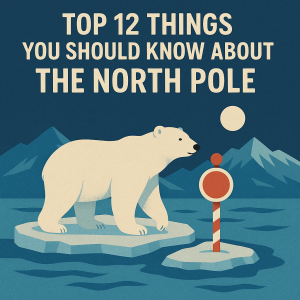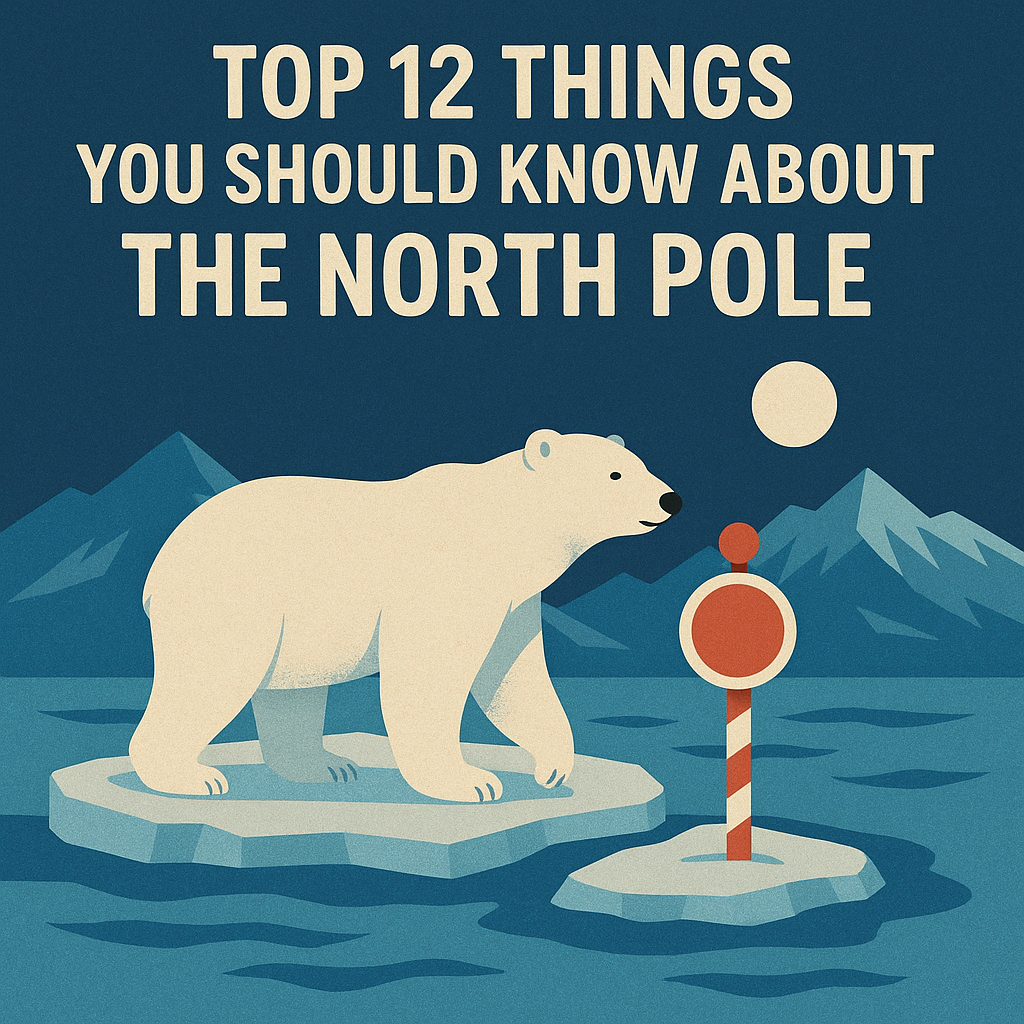Explore the top 12 most fascinating things you should know about the North Pole, from its shifting ice and geopolitical significance to climate science, Arctic navigation, and the future of polar shipping routes.

Why the North Pole Matters in Modern Maritime Operations
The North Pole has captivated explorers, scientists, and storytellers for centuries. But beyond the legends of Santa Claus and polar bears lies a region of growing geopolitical, environmental, and maritime importance. As climate change alters the Arctic’s icy landscape, the North Pole is transforming from an inaccessible frontier to a hub of scientific research, resource competition, and international shipping.
For maritime professionals and enthusiasts, the North Pole isn’t just a geographical curiosity—it’s a crucial reference point shaping Arctic navigation, environmental protection policies, and the future of global trade. With polar shipping routes opening, understanding the North Pole’s dynamics has never been more relevant.
1. There Is No Land at the North Pole
Unlike Antarctica, which is a continent covered by ice, the North Pole is simply a point in the Arctic Ocean covered by drifting sea ice. If you were to stand there, you’d be floating on a sheet of ice above some of the deepest parts of the ocean.
Why It Matters: Ships navigating the Arctic must adapt to ice that shifts unpredictably, unlike the fixed landmass of the South Pole. Polar-class vessels and icebreaker support are essential for safety.
2. The Ice Is Rapidly Disappearing
According to the Intergovernmental Panel on Climate Change (IPCC) and recent reports from the National Snow and Ice Data Center (NSIDC), Arctic sea ice has declined by more than 40% since satellite records began in 1979. The summer minimums are getting lower each decade.
Consequences for Maritime Transport: Shrinking ice opens new shipping lanes, such as the Northern Sea Route (NSR) along Russia’s coast. But it also introduces new risks—icebergs, unpredictable freeze-thaw cycles, and environmental hazards.
3. There Are Actually Two North Poles
Most people refer to the Geographic North Pole, located at 90°N latitude. But there’s also the Magnetic North Pole, which shifts due to changes in Earth’s core. As of 2025, it’s located near the Canadian Arctic Archipelago and is moving toward Siberia at a rate of about 40–50 kilometers per year.
Implications for Navigation: This drift affects compass-based systems and requires constant recalibration of maritime navigation charts. The IMO recommends regular updates via the ECDIS and bridge equipment under STCW guidelines.
4. The Arctic Is an Emerging Shipping Route
The melting of Arctic sea ice has introduced the Northern Sea Route (NSR) and Transpolar Sea Route (TSR) as potential alternatives to traditional passages like the Suez Canal. COSCO Shipping and Sovcomflot have conducted commercial voyages, with LNG tankers and container ships using these routes under icebreaker escort.
Key Insight: According to the International Maritime Organization (IMO), Arctic shipping is governed by the Polar Code (in force since 2017), which mandates specific vessel design, equipment, and crew training for polar waters.
5. Indigenous Peoples Have Lived Near the Arctic for Thousands of Years
While no one lives at the North Pole, several Indigenous groups—including the Inuit, Sámi, Nenets, and Chukchi—inhabit the Arctic regions surrounding it. These communities maintain deep cultural and ecological knowledge of the region.
Importance in Policy: Their traditional practices are increasingly being consulted in Arctic governance discussions, such as through the Arctic Council.
6. Territorial Claims Are Heating Up
Five countries border the Arctic Ocean—Canada, Russia, the United States, Norway, and Denmark (via Greenland). All have submitted claims to the United Nations Commission on the Limits of the Continental Shelf (CLCS) to extend their jurisdiction under UNCLOS.
Example: In 2023, the UN partially approved Russia’s claim to seabed rights extending up to the North Pole, intensifying geopolitical competition for oil, gas, and mineral resources.
7. It’s Harder to Get to the North Pole Than You Think
Despite the melting ice, reaching the North Pole remains logistically challenging. Icebreakers like Russia’s 50 Let Pobedy or scientific expeditions such as MOSAiC (2020) are required. Commercial tours exist but are expensive and seasonal.
Stat: Fewer people have stood at the North Pole than have climbed Mount Everest—an estimated 1,000–2,000 total.
8. The North Pole Plays a Key Role in Climate Science
The Arctic acts as a climate regulator by reflecting solar energy via its bright, icy surface—a phenomenon known as albedo. As ice melts, darker ocean water absorbs more heat, accelerating warming.
Scientific Relevance: According to NASA, the Arctic is warming nearly four times faster than the global average. This “Arctic amplification” has implications for global weather systems and ocean circulation.
9. Submarine Navigation Beneath the Pole Is Strategic
Since the Cold War, submarines—especially nuclear-powered ones—have traveled beneath the polar ice. The U.S. Navy and Russian Navy have both conducted submarine surfacing drills at or near the North Pole.
Modern Context: The Arctic remains strategically significant for national defense and under-ice naval mobility.
10. Satellite Coverage and Communication Are Still Challenging
High-latitude areas experience signal degradation due to satellite orbital patterns. Maritime communications (Inmarsat, Iridium, Starlink) are adapting, but gaps persist, especially during polar night and storms.
Progress: The IMO and IHO are working with industry players to improve satellite navigation reliability in the polar regions. Inmarsat’s new Arctic payloads (2023) aim to improve broadband for vessels.
11. Tourism at the Top of the World Is Rising
Polar tourism, including icebreaker cruises to the North Pole, has grown steadily. According to the International Association of Antarctica Tour Operators (IAATO), Arctic tourism increased by 75% between 2016 and 2023.
Concern: With more ships in fragile polar ecosystems, the risk of oil spills, wildlife disturbance, and search and rescue operations increases—triggering stricter environmental controls under MARPOL and the Polar Code.
12. The Future of the North Pole Is Uncertain
The North Pole stands at the intersection of global challenges—climate change, rising sea levels, shipping expansion, and geopolitical competition. What happens here affects everywhere else.
Quote: “What happens in the Arctic doesn’t stay in the Arctic.” – United Nations Environment Programme (UNEP)
Real-World Maritime Applications
1. Ice-Class Vessel Development
Classification societies such as DNV, Lloyd’s Register, and Bureau Veritas have introduced Polar Class notations for vessels, from cargo ships to tankers. These determine how thick the ice can be for a ship to operate safely.
2. Enhanced Bridge Training
Under IMO Model Course 1.30, bridge officers are trained to navigate in ice-covered waters using radar, satellite data, and simulation-based scenarios.
3. Port Infrastructure in the Arctic
Russia has invested in ports like Murmansk and Sabetta to support NSR cargo. Canada’s Churchill Port is also gaining attention for northern access.
4. International Cooperation Through the Arctic Council
The Arctic Council coordinates scientific research, indigenous engagement, and environmental standards. It includes Arctic states and observers such as China, Japan, and the EU.
Frequently Asked Questions (FAQ)
Is the North Pole in international waters?
Yes, the North Pole lies in international waters, though nearby seabeds are subject to overlapping claims.
Can ships sail directly over the North Pole?
Technically yes, but it’s rare. Ice conditions, lack of infrastructure, and navigational hazards make it impractical for regular commercial shipping.
Are there permanent settlements at the North Pole?
No. The closest year-round inhabited station is Alert, Canada, located about 817 km away.
Why does the Magnetic North Pole move?
It moves due to dynamic changes in Earth’s liquid iron outer core. This affects compass accuracy and aviation/maritime charts.
What laws apply in the Arctic Ocean?
UNCLOS governs maritime zones, while the IMO Polar Code and SOLAS apply to vessel safety. Environmental rules also fall under MARPOL Annexes I and V.
What animals live at the North Pole?
No land animals live on the North Pole, but polar bears, Arctic foxes, seals, and whales live in nearby regions.
Is Arctic shipping environmentally safe?
It poses risks. Black carbon emissions, oil spills, and ice disturbance are major concerns, prompting regulatory measures by the IMO and Arctic Council.
Conclusion
The North Pole is more than just a frozen point at the top of our planet—it’s a dynamic, evolving space that reflects the intersection of nature, politics, commerce, and climate. As polar ice recedes and interest in Arctic navigation grows, understanding the realities of the North Pole becomes essential for maritime stakeholders.
From ice-class vessel design and geopolitical claims to indigenous knowledge and climate science, each of the 12 insights shared here reveals why the North Pole is no longer out of reach—it’s at the center of global attention.
Maritime professionals, students, and enthusiasts should keep a close watch. The future of the Arctic is unfolding before us, and its icy frontier may shape the next chapter of maritime history.
References
- International Maritime Organization (IMO). (2023). Polar Code. https://www.imo.org
- National Snow and Ice Data Center (NSIDC). (2024). Arctic Sea Ice News & Analysis. https://nsidc.org/arcticseaicenews/
- Arctic Council. (2023). About the Arctic. https://arctic-council.org/
- United Nations Convention on the Law of the Sea (UNCLOS). https://www.un.org/depts/los/
- NASA Earth Observatory. (2023). Arctic Amplification and Climate. https://earthobservatory.nasa.gov/
- IAATO. (2023). Arctic and Antarctic Tourism Reports. https://iaato.org/
- DNV. (2023). Ice Class Notation Guidelines. https://www.dnv.com/
- U.S. Geological Survey. (2023). Magnetic North Pole Movement. https://www.usgs.gov/
- British Antarctic Survey (BAS). Arctic Sea Ice. https://www.bas.ac.uk/
- United Nations Environment Programme (UNEP). (2023). Arctic Initiatives. https://www.unep.org/

